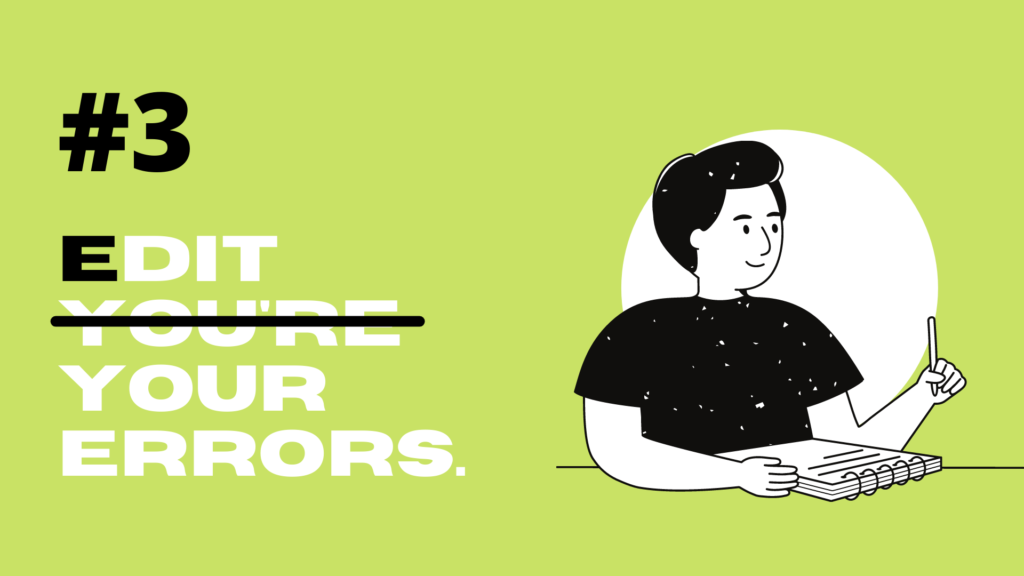Achieving the Perfect Copy isn’t done by just forming and typing out your thoughts and finalizing the content with a punctuation mark. No. The process is much more time-intensive and grueling than that. Proofreading is a must, regardless of the type of content you’re producing.
Now, proofreading is more than just correcting errors. It’s mostly that, sure, but proofreading also aims to create the best potential outcome that will keep your readers interested. This means editing out any mistakes and fine-tuning the ideas that you have laid out on paper.
Sounds daunting? It is, especially to newbie content writers or for solopreneurs who do everything themselves. But the process can be made easy with the Three Es. Hopefully, keeping these in mind will lead you to construct concise copies that are both sharp and interesting.
Follow the three e’s:

When creating a decent copy for whichever type of content, it’s always essential to keep your piece engaging.
1. Find your audience
One of the first proofreading tips in creating an excellent copy is finding your target audience. Answer the question, “who are you writing for?”. It’s essential to identify who your audience is and what their needs are. Your written piece’s target audience will always have specific questions and seek answers through your copy.
Have a list of questions that your audience might need to know about your product or service. Then by answering all these questions, you can reduce the time spent on thinking of content.
2. Attention span
Before you begin writing down your copy, always consider people’s attention span. This means taking into consideration factors such as word count and where you will publish your content.
On average, the word count for content published on websites is around 1000-1900 words. But also remember that people are busy. Some might have time for an article with 2000 words, while some do not. Find a word count that fits your target audience and consider where you will publish the content. After all, a 1000 word piece would fit perfectly on websites, but a 1000 word post on Facebook will only lower your engagement.
3. Keyword research
Keywords are essential in creating content copies because this factor is what brings your content to search engines. People search for answers to their questions on search engines using keywords.
Basically, the more keywords in your content, the more likely it becomes that it will reach a greater audience. Adding the right keywords to your content is one of the great proofreading tips to incorporate into your copy.

Finding errors to correct in your copy is one thing and revising it to reach its full potential is another. Here are proofreading tips to consider on editing and improving your content.
1. Concise copies
Keeping your audience’s engagement is about making things quick and easy to consume. It doesn’t need highfalutin, flamboyant, unnecessary flowery words. It’s better to use simple words that the general public would understand. Edit your copy to be more concise to keep your audience’s interest.
2. Use active voice
Now that you have written the draft for your content, an important factor in editing is changing your sentences into an active voice.
Having an active voice allows your audience to believe that the content calls them to take action in your products or services. Using an active voice in your copywriting also allows your business to have more potential customers that are now invested through your content.
3. Short paragraphs
As previously stated, people are busy and often have short attention spans, so a huge block of text in your piece might just have people clicking the exit button.
Review your article and make sure you keep your paragraphs short. Break them down into smaller parts with headings divided in bold fonts. It allows your audience to read through your article easier.
4. Add photos
Many people are more visually inclined. Having photos makes it easier for them to pick up concepts, and it’s a quicker way of processing information than reading.
Sometimes photos don’t even need to be informational. It can be added as “decoration” to keep your audience engaged and have something to look at. They say that a picture says a thousand words, so having photos in your piece might explain your content better than your own words.
5. Add bullet points
As with the previous tip, it is also best to improve your copy by replacing long paragraphs with short and direct bullet points. Not only does this keep your copy concise, but it also helps your audience grasp specific topics quicker.
Some readers might even read your content as research or as a reference. With bullet points in your piece, it helps your reader come back to specific parts of your work where concepts have been condensed bullet points.
6. Format matters
Some people are avid readers, and some are casual. But even when you find your target audience, you wouldn’t know precisely which one is the avid reader and which one isn’t. The key is finding the right balance in your copy.
In the end, formatting matters. Breaking down your content into unique subheadings, having visual aid and lists within a certain point gives your audience something else to look at besides blocks of text. It all adds to the impression that your content is short and, therefore, can be quickly consumed and keep your audience engaged.

Finally, your article has been conceptualized, drafted, edited, and revised into its full content potential. Now it’s time to correct your sentence-level errors by the laws of grammar. Here are more proofreading tips:
- Take a break
You’ve finally finished your whole piece. Now it’s time to take a break. Clear your head first. It’s always better to proofread errors when your mind is fresh.
- Golden hour
Proofreading when you’re drowsy or sleepy can make you miss a lot of errors. Proofread at the time of the day when you are most alert.
- Error checklist
Once you’re back on your writing desk, make a checklist for errors you usually make before proofreading. Recognize the same mistakes that you’ve been making, and then gradually correct them. The idea is that for succeeding written works, you will avoid making the same mistakes.
- One problem at a time
Finding all kinds of errors in punctuations, spelling, grammar all in one go increases the risk of missing a lot more. It will be less effective. The best way to go about it is to proofread one problem at a time.
- Check every first word
Sometimes we tend to sound monotonous even without any idea. Make sure that every first word in each paragraph has variety.
- Dictionary at the ready
When your mind thinks faster than you write, there is a tendency to have an incorrect spelling for words that sound the same. Homonyms are common proofreading errors, so it’s best to have your dictionary ready to make sure you’re using the right words.
- Spellcheck is a friend
Spellcheck is a friend, but sometimes it’s a foe. You can’t rely on your spell-checking app to catch all errors in your content. It’s best to read through it yourself just to be sure.
- Proofread backwards
Going from the last word of your copy to the very beginning may seem inefficient and time costly, but it does allow you to focus on one aspect: the spelling. Factors like punctuations, grammar, and ideas won’t make sense, so you have fewer chances of getting distracted while editing out any spelling errors you might have made. This step is significant because you can’t always rely on a machine.
- Highlight keywords
As stated previously, keywords play a big role in creating marketing copies. Highlight the keywords used in your content to count how many times they were used and check if they are spread out evenly.
- Print on paper
Once the previous steps have been done, print a hard copy of your content. Changing your view is effective in catching the last few errors.
- Read to yourself
Take the time to read your work out loud. Hearing your content out loud can allow you to check the pace and clarity of your work.
- Let others read
This is one of the many proofreading tips writers don’t utilize often. Let others read your work. It can help catch errors you may have missed and may even allow you access to a new perspective on the content.
- Read it again
Finally, the last of many proofreading tips include rereading the copy. Reading is a natural part of the writing process, after all, one that gives you the chance to know your copy better from content to structure. If doing this digitally, changing up the format (may it be the font style, article sizing, or color used) can even help you catch errors you may have missed the first time around.
- Go easy on yourself
Remember! Proofreading takes up a lot of time and effort, as previously mentioned. You’ll need to address several problems in your writing, from content to formatting, so it’s understandable if you need to step away from your copy for a few moments.
If your deadline permits it, why not read existing content (either under your name or others’)? Doing so helps clear your head and even offers a glimpse of what a copy close to perfection looks like.


